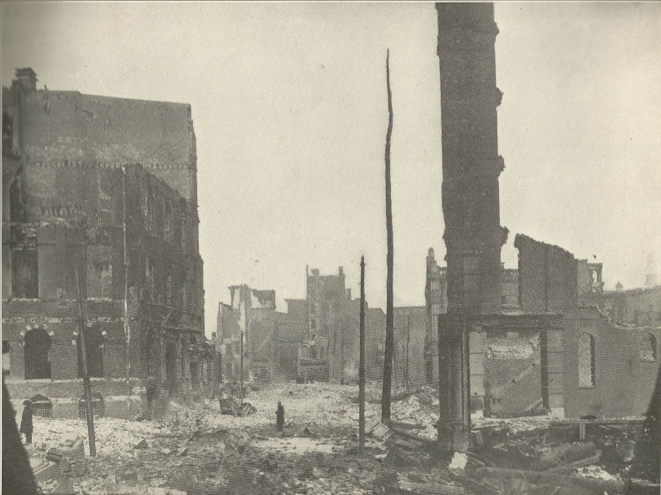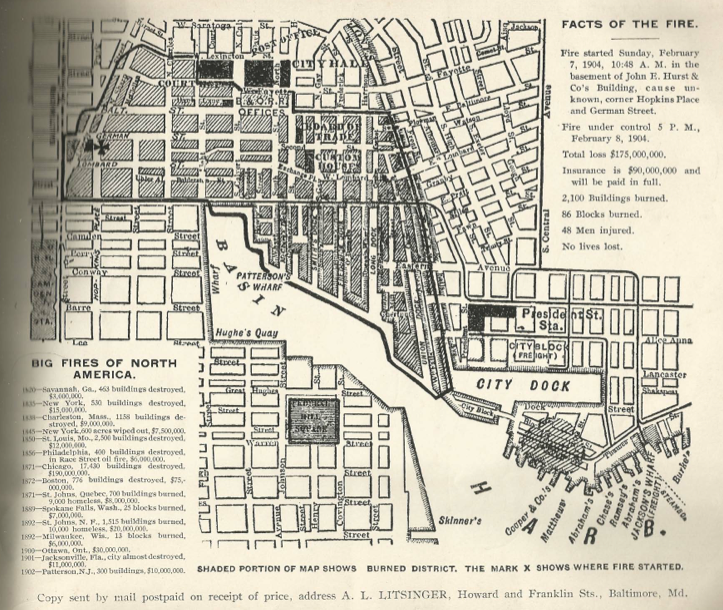The Great Baltimore Fire
I was recently reminded that 110 years ago today, a horrific fire swept through downtown Baltimore near the inner harbor. It was the third-worst fire in American history, behind the 1871 Chicago fire, and the 1906 San Francisco earthquake/fire.
It started in the basement of the Hurst Building. Though we don’t know for sure, it may have been caused by a dropped cigar or cigarette left smoldering overnight among stacks of cotton fabric that were in storage there.

By the time firefighters arrived just before 11am, the blaze was already out-of-control. The building partially exploded, sending flaming debris flying onto adjacent structures. Strong winds from the southwest gusting up to 30 mph also helped spread the destruction. Within an hour, firefighters recognized the severity of the situation, and a distress call was put out for help from other fire departments, and they came from as far away as New York.
There was an early attempt to create a fire-break by blowing up the surrounding buildings with dynamite. The mayor endorsed this plan with the thought that it would save more property than it would destroy, but many of the buildings were too strong to collapse, and the additional explosions only served to create more fires.
It wasn’t until the fire reached the Jones Falls, and almost 1,700 firefighters had labored for nearly 2 days, that the fire was finally brought under control. In all, almost 1,500 buildings spread over 140 acres of the city’s central business district were completely destroyed. Estimated damages totaled perhaps as high as $175 million (roughly $4.4 billion in today’s dollars), with only about $32 million of that loss insured. As many as 35,000 people were put out of work by the disaster.

Despite all the destruction of property, the death toll was almost non-existent. Many sources report that there were no deaths as a result of the fire, but there was at least one badly burned body discovered in the harbor in the days following the event. Several first responders also suffered injuries that would eventually lead to their death, but all-in-all, the damage was much greater in economic terms than in human ones.
Amazingly, the city was able to (literally) rise from the ashes very quickly. Within 2 years, almost the entire area had been rebuilt using new city-wide fire codes, and more fire-resistant materials. Even in the wake of tragedy, Baltimore got to have a fresh start.
I first wrote about this local disaster a few months ago when I discovered a book about the fire among my grandfather’s things. I still have a PDF scan of the book available for people who want to see more photos of the destruction.
Update: A friend points out in the comments that there is a great animated map of the fire that gives more detail of how it spread. It’s definitely worth checking out. Thanks, Laura!
Update 2: My mother-in-law pointed out this wonderful collection of photos posted by the Baltimore Sun on the anniversary. I’d never seen a lot of these. Thanks, Karen!
something i came across awhile ago that you might like: http://www.mdch.org/fire/
Yes! Thanks, Laura. I came across the same site this morning and was planning on putting an update with the link at the bottom of the post. Now I won’t have to! 🙂
i’m a mind reader. i read minds. apparently. 🙂